How listed companies represented by Strategy (MSTR) build Bitcoin reserves through innovative financial instruments (including preferred stocks, zero-coupon convertible bonds, etc.), focusing on their unique mNAV valuation model, anti-dilution mechanism, and Gamma Trading strategy, showcasing the fusion and innovation between traditional financial markets and crypto assets.
Introduction
By mid-2025, an increasing number of listed companies began to incorporate cryptocurrencies (especially Bitcoin) into their corporate treasury asset allocation, inspired by the successful case of Strategy ($MSTR). For instance, according to blockchain analysis data, in June 2025 alone, 26 new companies added Bitcoin to their balance sheets, bringing the total number of companies holding BTC globally to about 250.
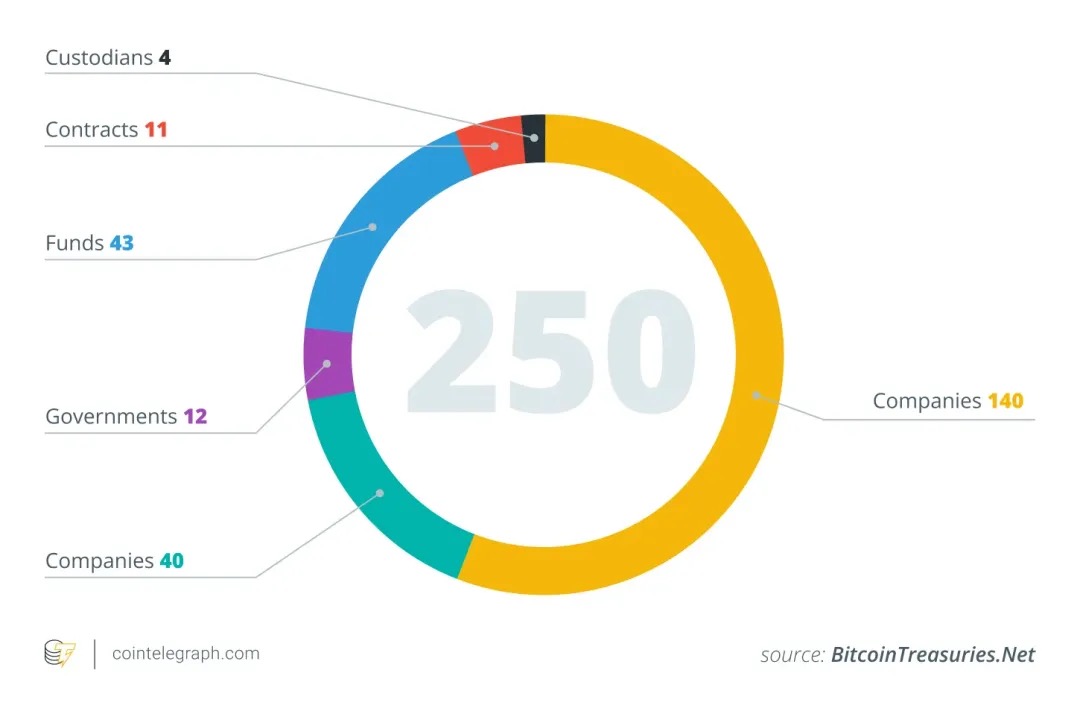
These companies span multiple industries (technology, energy, finance, education, etc.) and different countries and regions. Many companies view Bitcoin's limited supply of 21 million as a hedge against inflation and emphasize its low correlation with traditional financial assets. This strategy is quietly moving towards the mainstream: as of May 2025, 64 companies registered with the SEC collectively held about 688,000 BTC, accounting for approximately 3-4% of Bitcoin's total supply. Analysts estimate that over 100-200 companies globally have incorporated crypto assets into their financial statements.
Model of Crypto Asset Reserves
When a listed company allocates part of its balance sheet to cryptocurrencies, a core question arises: how do they finance the purchase of these assets? Unlike traditional financial institutions, most companies adopting a crypto treasury strategy do not rely on cash flow from their core business to support this. The following analysis will take $MSTR (MicroStrategy) as the main example, as most other companies are effectively replicating its model.
Operating Cash Flow
While theoretically the "healthiest" and least dilutive way is to purchase crypto assets using free cash flow generated from the company's core business, in reality, this approach is nearly impossible. Most companies lack sufficiently stable and large-scale cash flow to accumulate significant reserves of BTC, ETH, or SOL without external financing.
Taking MicroStrategy (MSTR) as a typical example: the company was founded in 1989 and originally focused on business intelligence software, with core products including HyperIntelligence and AI analytics dashboards, but these products still generate limited revenue. In fact, MSTR's annual operating cash flow is negative, far from the hundreds of billions it has invested in Bitcoin. Thus, it is evident that MicroStrategy's crypto treasury strategy has never been based on internal profitability but rather relies on external capital operations.
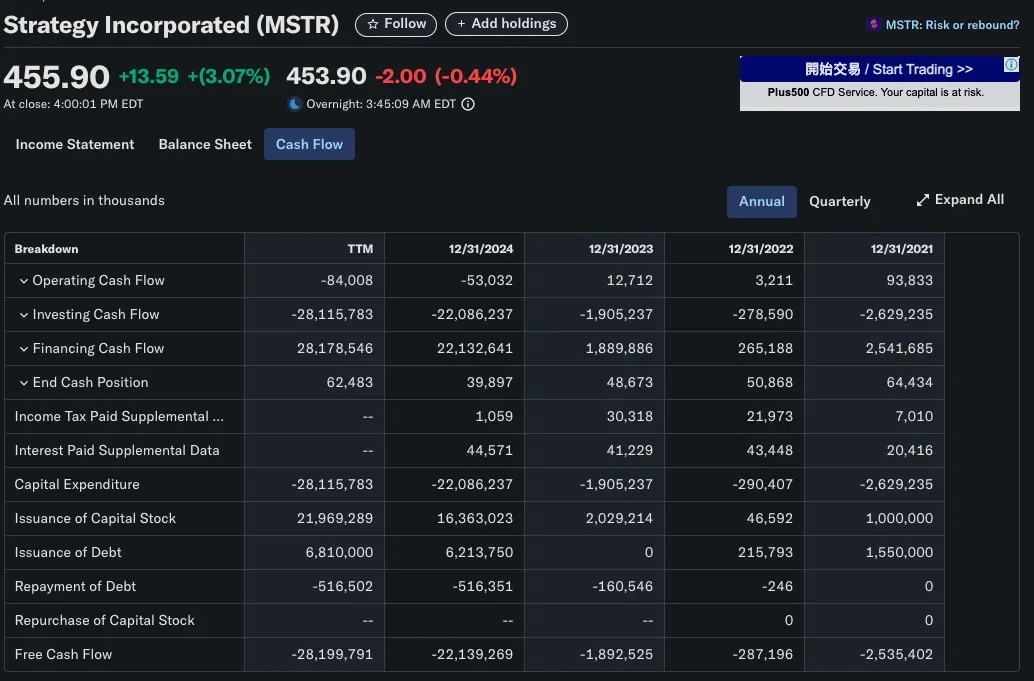
A similar situation is seen in SharpLink Gaming (SBET). The company transformed into an Ethereum treasury vehicle in 2025, acquiring over 280,706 ETH (approximately $840 million). Clearly, it could not rely on revenue from its B2B gaming business to achieve this operation. SBET's capital formation strategy primarily relies on PIPE financing (Private Investment in Public Equity) and direct stock issuance, rather than operating income.
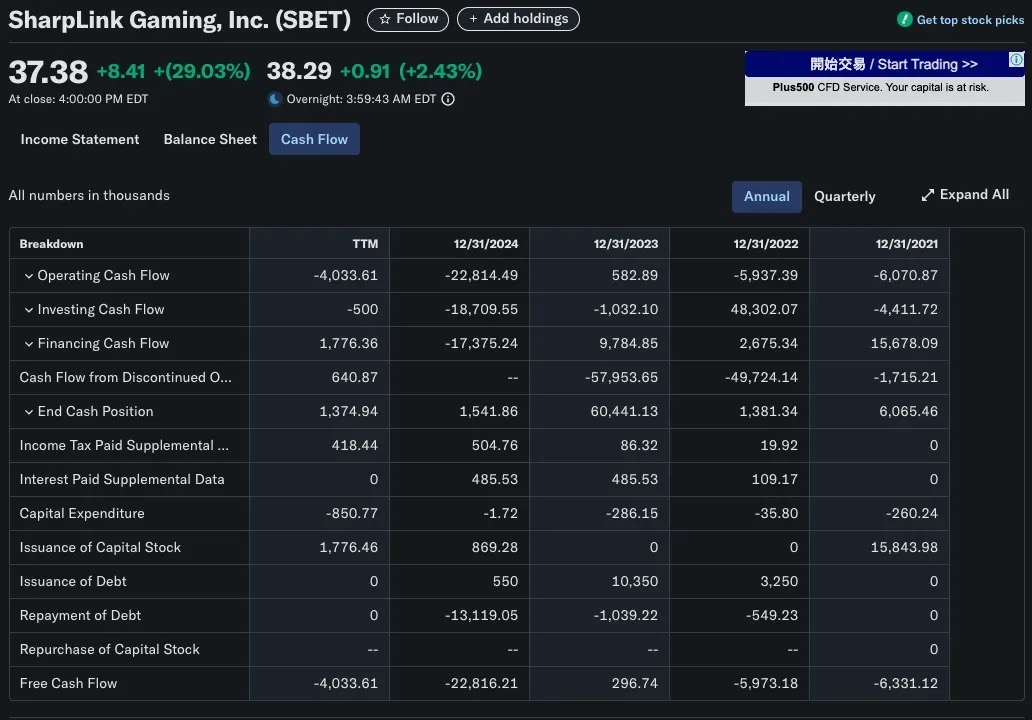
Capital Market Financing
Among listed companies adopting a crypto treasury strategy, the most common and scalable method is public market financing, raising funds through the issuance of stocks or bonds and using the proceeds to purchase Bitcoin and other crypto assets. This model allows companies to build large-scale crypto treasuries without tapping into retained earnings, fully leveraging financial engineering methods from traditional capital markets.
Issuing Stocks: Traditional Dilutive Financing Case
In most cases, issuing new shares comes with costs. When a company raises funds by issuing additional shares, two things typically happen:
Ownership is diluted: the ownership percentage of existing shareholders decreases.
Earnings per share (EPS) decline: with net profit unchanged, an increase in total shares leads to a decrease in EPS.
These effects often lead to a drop in stock price for two main reasons:
- Valuation logic: If the price-to-earnings (P/E) ratio remains unchanged while EPS declines, the stock price will also fall.
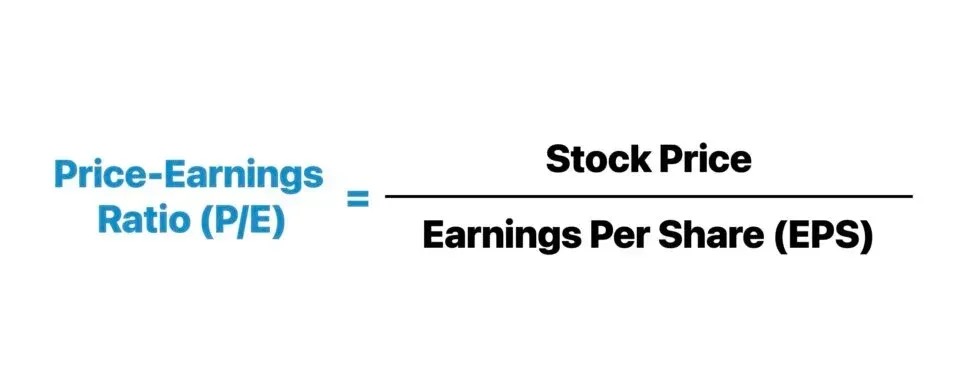
- Market psychology: Investors often interpret financing as a sign that the company lacks funds or is in distress, especially when the raised funds are for unproven growth plans. Additionally, the influx of new shares into the market creates supply pressure that can lower market prices.
An Exception: MicroStrategy's Anti-Dilution Equity Model
MicroStrategy (MSTR) is a typical counterexample to the traditional narrative of "equity dilution = harm to shareholders." Since 2020, MSTR has actively used equity financing to purchase Bitcoin, with its total outstanding shares growing from less than 100 million to over 224 million by the end of 2024.
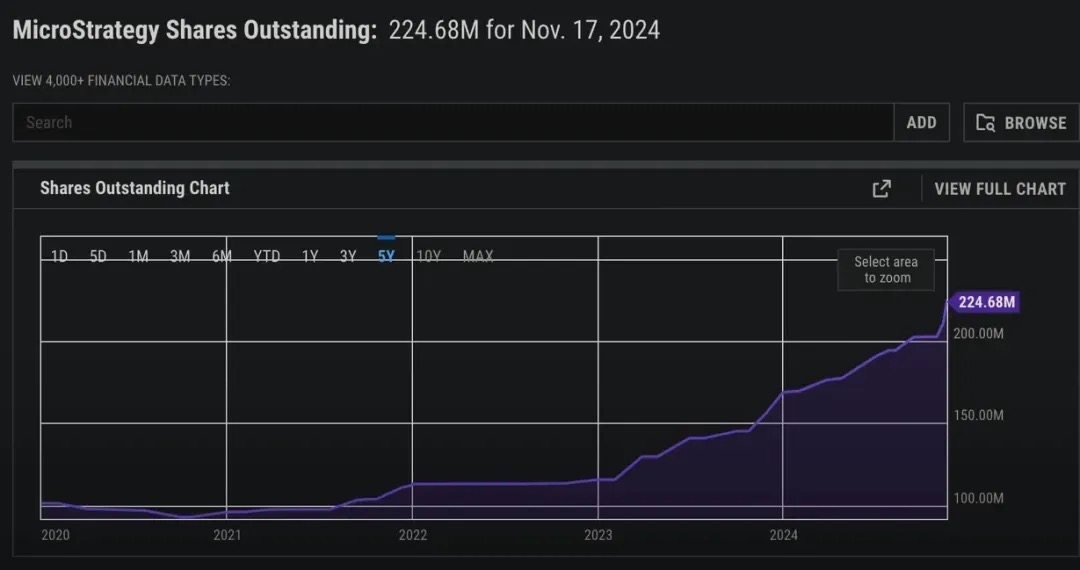
Despite the dilution of equity, MSTR's performance often exceeds that of Bitcoin itself. Why? Because MicroStrategy has long been in a state where "market value exceeds the net value of its held Bitcoin," which we refer to as mNAV > 1.
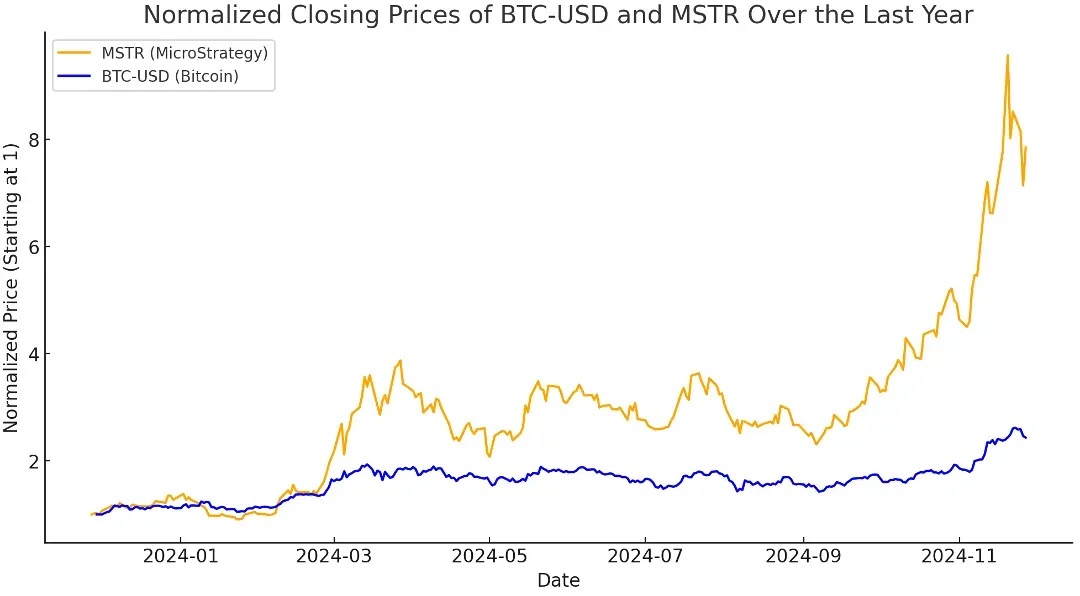
Understanding Premium: What is mNAV?

- When mNAV > 1, the market values MSTR higher than the fair market value of its held Bitcoin.
In other words, when investors gain Bitcoin exposure through MSTR, they pay a higher price per unit than the cost of directly purchasing BTC. This premium reflects the market's confidence in Michael Saylor's capital strategy and may represent the market's belief that MSTR offers leveraged, actively managed BTC exposure.
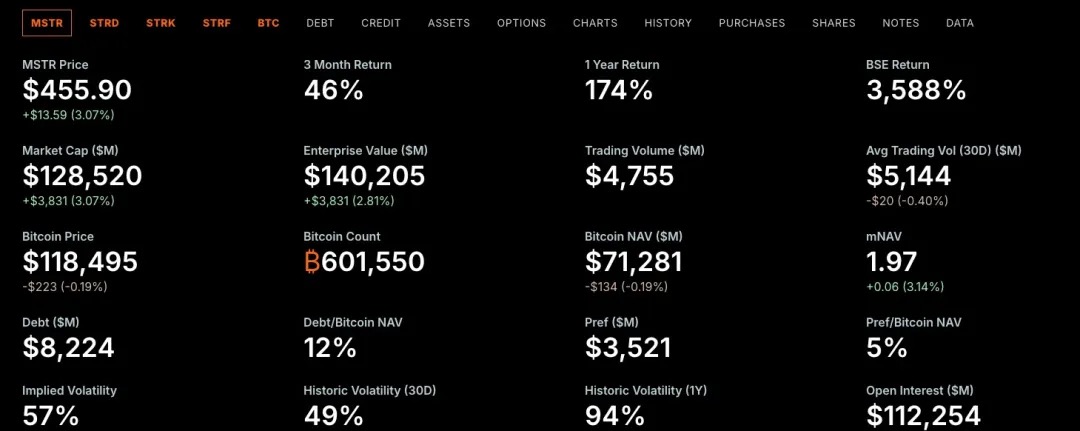
Support from Traditional Financial Logic
Although mNAV is a crypto-native valuation metric, the concept of "trading price exceeding the value of underlying assets" has long been prevalent in traditional finance.
Companies often trade at prices above their book value or net assets for several reasons:
Discounted Cash Flow (DCF) Valuation Method
Investors focus on the present value of a company's future cash flows, not just its currently held assets.
This valuation method often leads to companies trading at prices far above their book value, especially in the following scenarios:
Expectations of revenue and profit margin growth
The company possesses pricing power or technological/commercial moats
📌 Example: Microsoft's valuation is not based on its cash or hardware assets but on its future stable subscription software cash flows.
Earnings and Revenue Multiple Valuation Method (EBITDA)
In many high-growth industries, companies typically use P/E (price-to-earnings) or revenue multiples for valuation:
High-growth software companies may trade at 20-30 times EBITDA multiples;
Early-stage companies, even without profits, may trade at 50 times revenue or higher.
📌 Example: Amazon's P/E ratio reached 1078 times in 2013.
Despite thin profits, investors still bet on its future dominance in e-commerce and AWS.
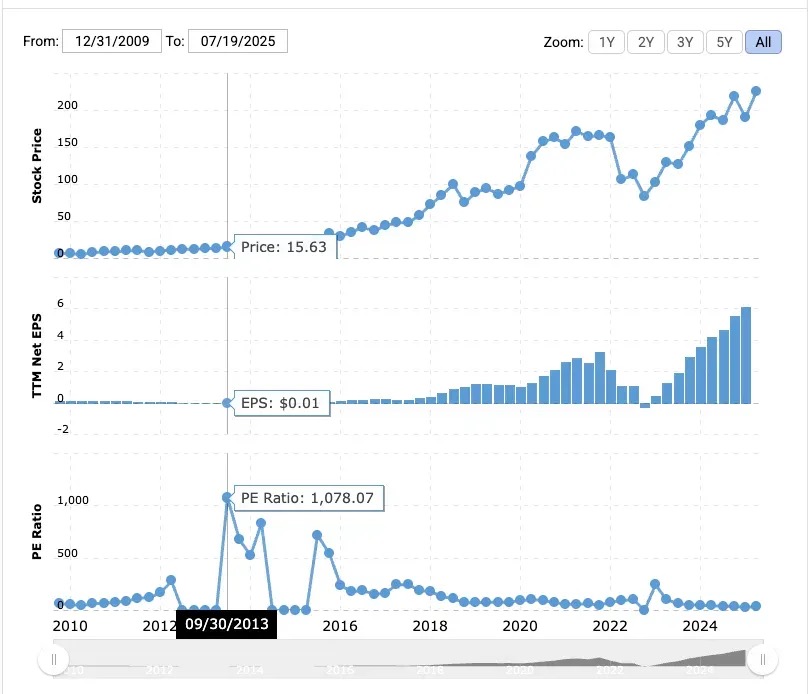
MicroStrategy has advantages that Bitcoin itself does not possess: a corporate shell that can access traditional financing channels. As a publicly traded company in the U.S., it can issue stocks, bonds, and even preferred equity to raise cash, and it has indeed done so with remarkable results.
Michael Saylor cleverly leverages this system: he raised billions of dollars through issuing zero-percent convertible bonds and recently launched innovative preferred equity products, investing all these funds into Bitcoin.
Investors recognize that MicroStrategy can use "other people's money" to purchase Bitcoin on a large scale, an opportunity that is not easily replicable by individual investors. The premium on MicroStrategy is "not related to short-term NAV arbitrage," but rather stems from the market's high trust in its capital acquisition and allocation capabilities.
How mNAV > 1 Achieves Anti-Dilution
When MicroStrategy's trading price exceeds the net asset value of its held Bitcoin (i.e., mNAV > 1), the company can:
Issue new shares at a premium price
Use the raised funds to purchase more Bitcoin (BTC)
Increase total BTC holdings
Drive NAV and enterprise value (Enterprise Value) to rise in sync
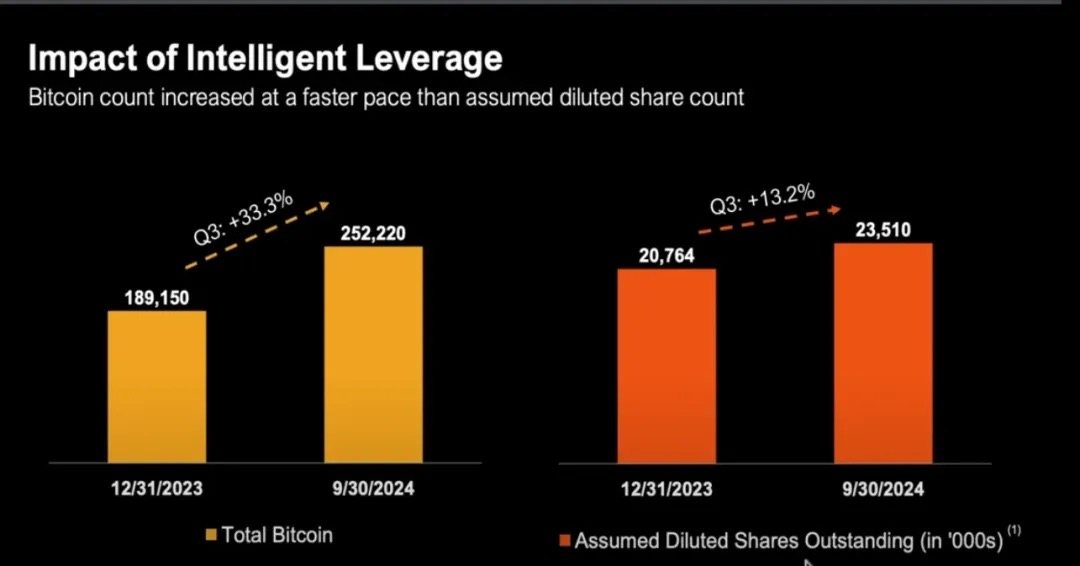
Even with an increase in outstanding shares, the amount of BTC held per share (BTC/share) may remain stable or even rise, making the issuance of new shares an anti-dilutive operation.
What Happens When mNAV = 1?
When mNAV = 1, it means that each dollar of MSTR stock represents a BTC market value exceeding one dollar (at least on paper).
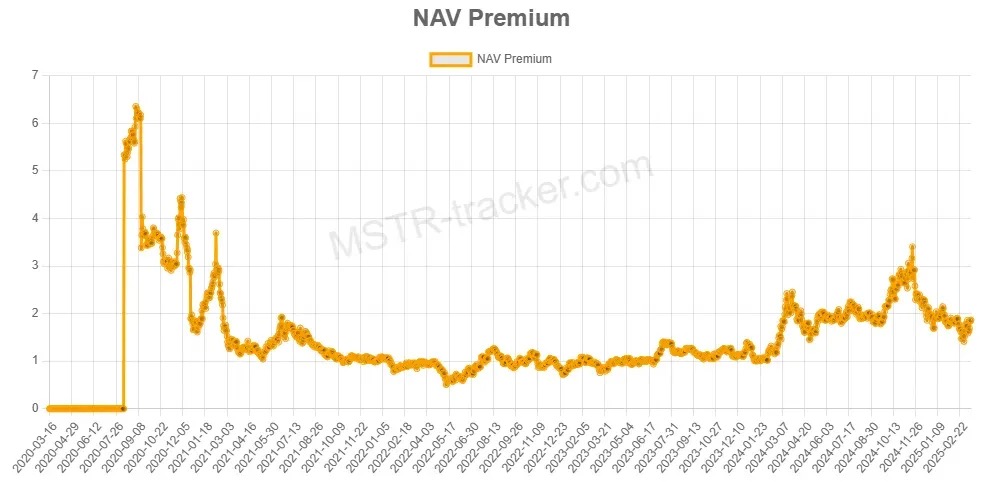
From a traditional finance perspective, MSTR is trading at a discount, i.e., below its net asset value (NAV). This presents challenges in capital allocation. If the company finances stock to buy BTC under these circumstances, from the shareholders' perspective, it is essentially buying BTC at a high price, thereby:
Diluting BTC/share (the amount of BTC held per share)
Reducing the value for existing shareholders
When MicroStrategy faces a situation where mNAV = 1, it will be unable to maintain the "issue new shares → purchase BTC → increase BTC/share" flywheel effect.
So what options are left at this point?
Buy Back Shares Instead of Continuing to Buy BTC
When mNAV = 1, buying back MSTR shares is a value-accretive action for several reasons:
You are buying back shares at a price below their intrinsic BTC value
As the number of outstanding shares decreases, BTC/share will rise
Saylor has explicitly stated: if mNAV is below 1, the best strategy is to buy back shares rather than continue to buy BTC.
Method 1: Issuing Preferred Stock
Preferred stock is a hybrid security that sits between debt and common equity in a company's capital structure. It typically offers fixed dividends, has no voting rights, and has priority over common stock in profit distribution and liquidation. Unlike debt, preferred stock does not require repayment of principal; unlike common stock, it provides more predictable income.
MicroStrategy has issued three types of preferred stock: STRK, STRF, and STRC.
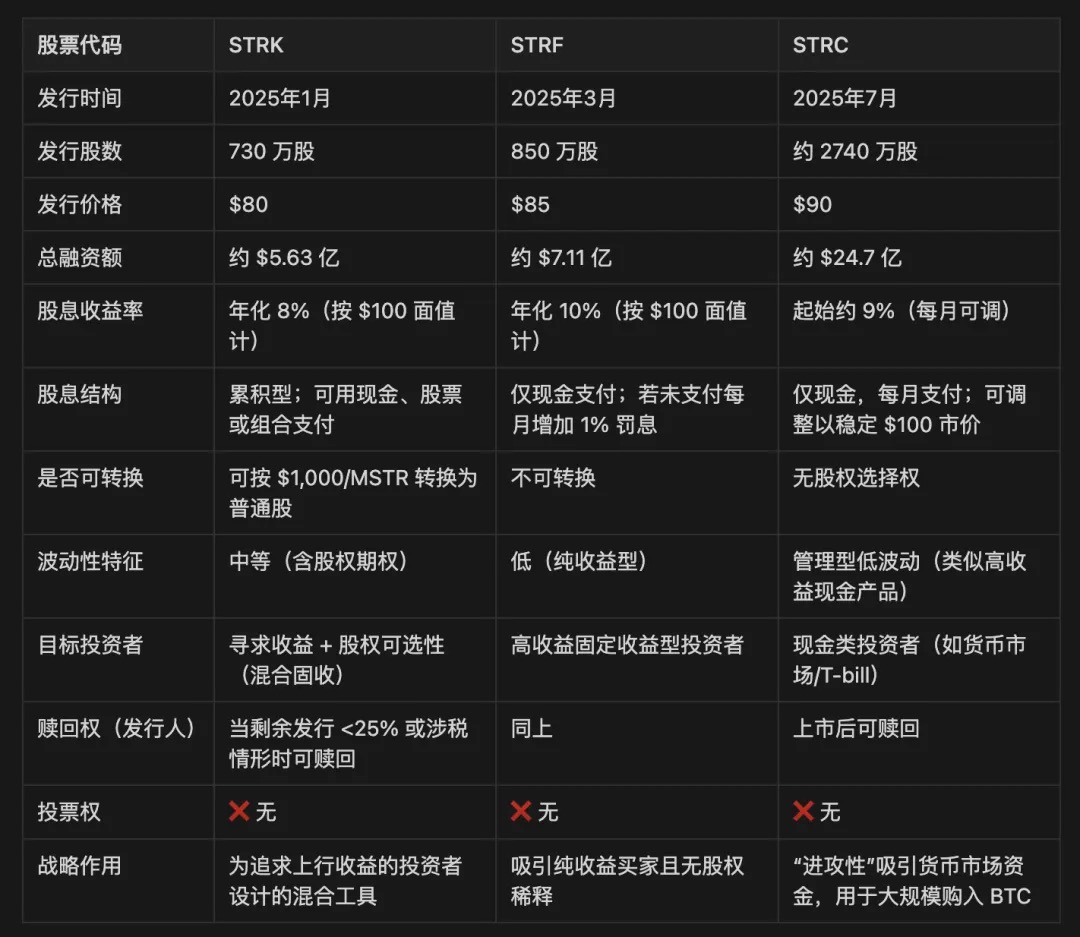
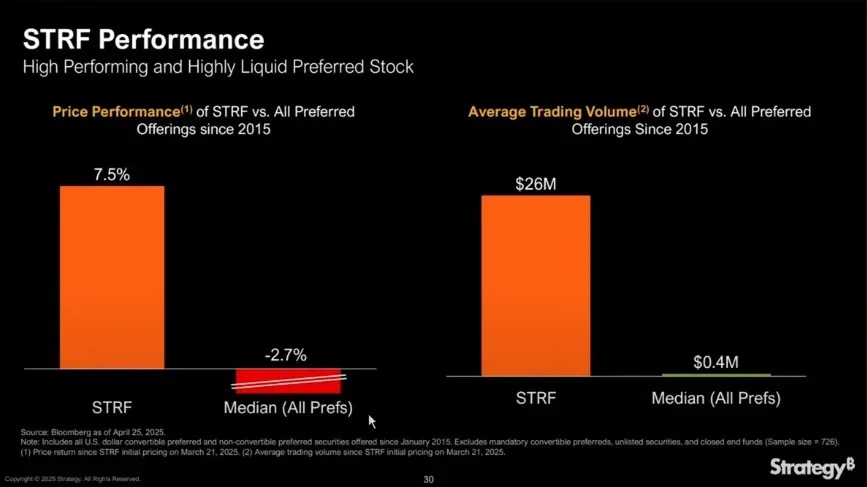
STRF is the most straightforward tool: it is a non-convertible perpetual preferred stock that pays a fixed cash dividend of 10% annually based on a $100 par value. It has no equity conversion option and does not participate in MSTR's stock price appreciation, only providing income.
The market price of STRF will fluctuate around the following logic:
If MicroStrategy needs financing, it will issue more STRF, increasing supply and driving the price down;
If market demand for income surges (e.g., during periods of low interest rates), the price of STRF will rise, thereby lowering the effective yield;
This creates a self-adjusting price mechanism, with a typically narrow price range (e.g., $80–$100), driven by yield demand and supply and demand dynamics.
Example: If the market demands a 15% yield, the price of STRF may drop to $66.67; if the market accepts 5%, it may rise to $200.
Since STRF is a non-convertible, essentially non-redeemable instrument (unless tax or capital trigger conditions occur), its behavior is similar to that of a perpetual bond, allowing MicroStrategy to repeatedly use it to "bottom out" BTC without needing to refinance.
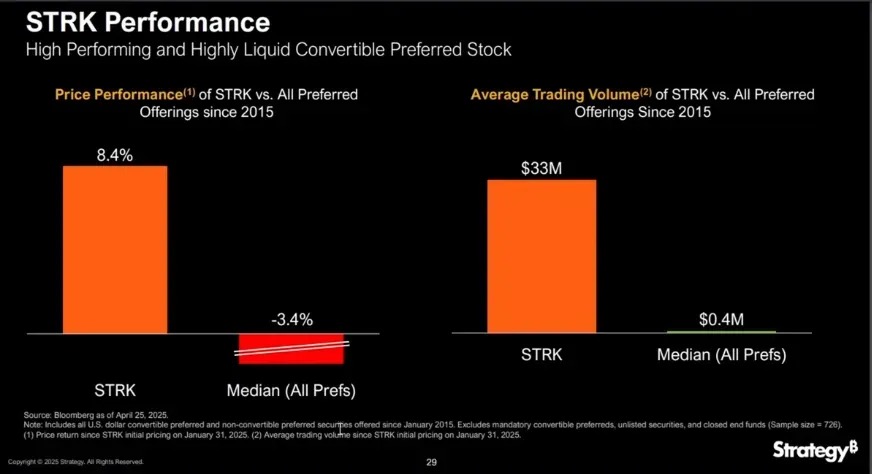
STRK is similar to STRF, with an annual dividend of 8%, but adds a key feature: it can be converted into common stock at a 10:1 ratio when MSTR's stock price exceeds $1,000, effectively embedding a deep out-of-the-money call option, providing holders with long-term upside opportunities.
STRK is highly attractive to both the company and investors for several reasons:
Asymmetric Upside Opportunity for MSTR Shareholders:
Each STRK share is priced at about $85, raising $850 for 10 shares;
If converted in the future to 1 share of MSTR, it means the company buys BTC at $850 at current prices, but dilution only occurs if MSTR's stock price exceeds $1,000;
Therefore, during the period when MSTR is at $1,000, it is non-dilutive, even after conversion, reflecting the appreciation from prior BTC accumulation.
Income Stabilization Structure:
STRK pays a quarterly dividend of $2, totaling $8 annually;
If the price drops to $50, the yield will rise to 16%, attracting buying support for the price;
This structure makes STRK behave like a "bond with options": defensive on the downside, participatory on the upside.
Investor Motivation and Conversion Incentives:
When MSTR's stock price exceeds $1,000, holders are incentivized to convert to common stock;
As MSTR continues to rise (e.g., to $5,000 or $10,000), the dividend from STRK becomes negligible (yielding only about 0.8%), accelerating conversion;
Ultimately forming a natural exit channel, converting temporary financing into a long-term shareholder structure.
MicroStrategy also retains the right to redeem STRK, under conditions including the remaining unconverted shares falling below 25% or special triggering events such as tax issues.
In the liquidation hierarchy, STRF and STRK rank above common stock but below debt.
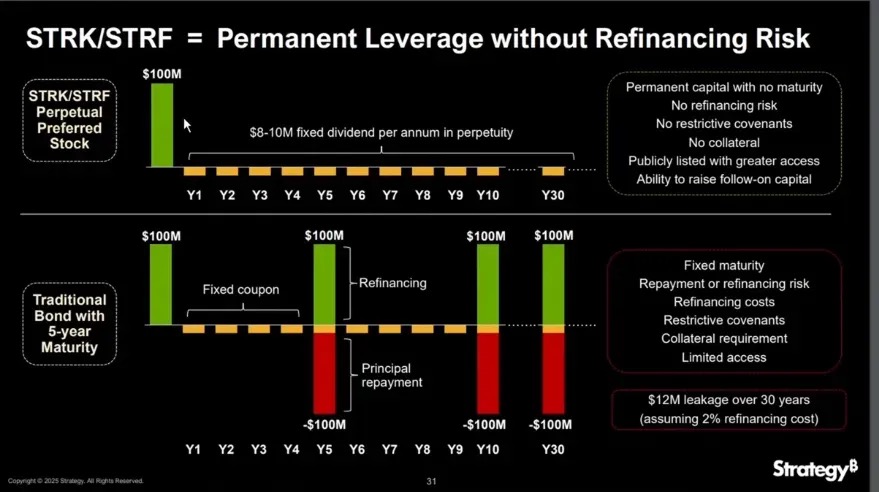
When the company is in a situation where mNAV = 1, these tools are particularly important. Because issuing common stock at a discount would dilute BTC/share, thereby reducing value. Preferred stocks like STRF and STRK allow the company to continue raising funds without diluting common stock, whether for continued Bitcoin purchases or share buybacks, maintaining the stability of BTC/share while expanding assets.
How Do They Pay Interest (Dividends)?
As of YTD 2025, MicroStrategy has raised $6.6 billion through ATM (At-The-Market) stock issuance, far exceeding its annual fixed interest and dividend cost of $185 million.
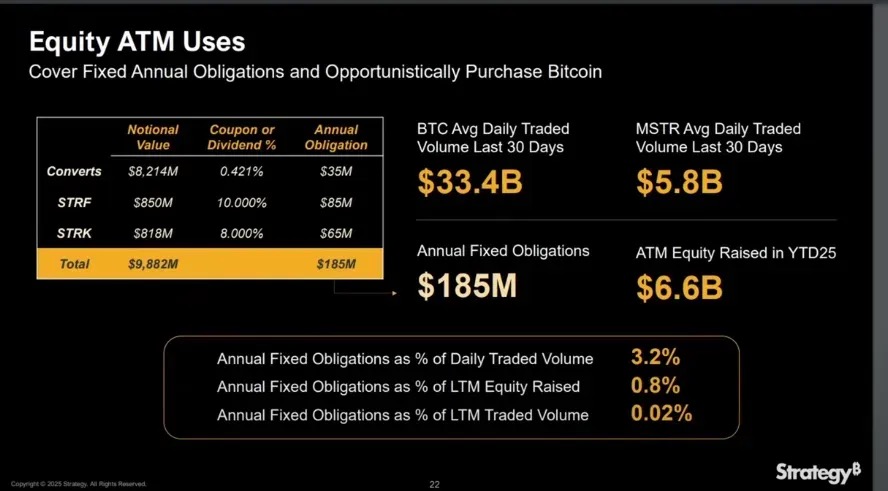
When mNAV > 1, paying preferred stock dividends through equity issuance does not dilute BTC per share, as the incremental BTC from the raised funds exceeds the unit dilution.
Additionally, preferred stock is not counted as debt, allowing MicroStrategy to continue expanding its balance sheet without worsening its net debt ratio, which is crucial for maintaining market confidence in its capital structure.
When mNAV > 1
Convertible Bonds
Convertible bonds are a type of corporate debt instrument that grants bondholders the right (but not the obligation) to convert the bonds into shares of the issuing company at a predetermined price (known as the conversion price) in the future. Thus, it essentially has a structure of bond + call option. This tool is commonly used in situations where mNAV > 1, as it is particularly suitable for accumulating Bitcoin.
Taking MicroStrategy's 0% convertible bonds as an example:
No interest is paid during the bond's term;
Only the principal needs to be repaid at maturity (unless investors choose to convert to stock);
For MSTR, this is an extremely capital-efficient financing method: it can raise billions of dollars to purchase Bitcoin without immediate dilution or interest burden, with the only risk being the need to repay the principal if the stock price performs poorly in the future.
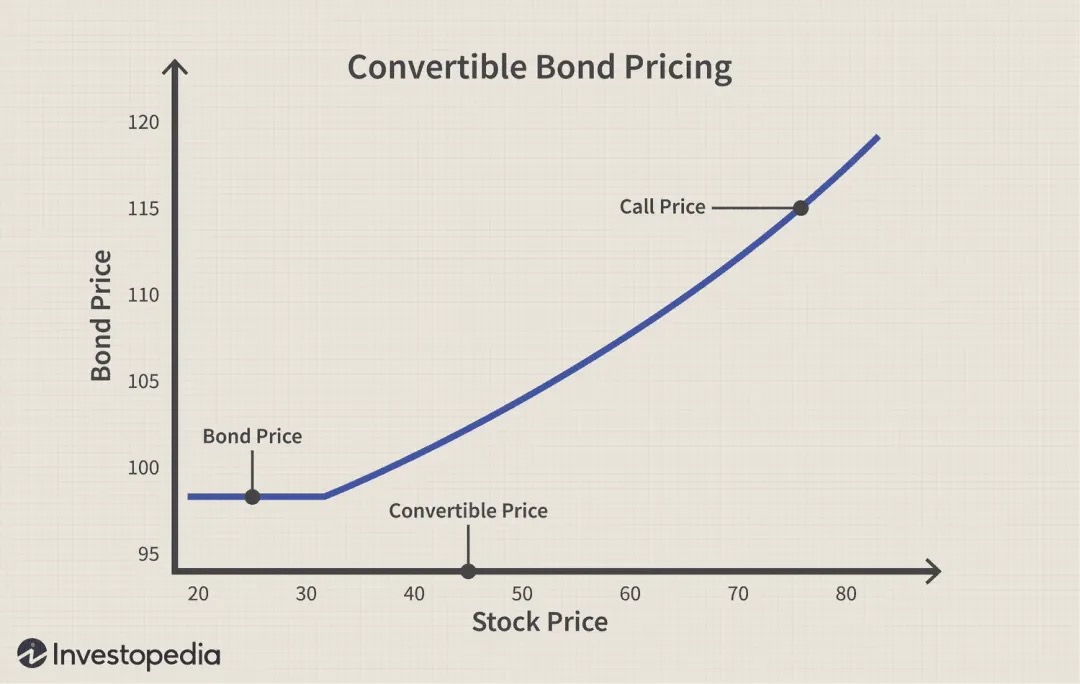
Case 1: Stock Price Surges Beyond Expectations
MicroStrategy issues convertible bonds to investors;
The company instantly receives $3 billion in funds to purchase Bitcoin;
Since the bonds have a 0% interest rate, MicroStrategy does not need to pay interest during the bond's term;
If MSTR's stock price rises above the conversion price threshold;
Investors choose to convert the bonds into stock or redeem the principal;
MicroStrategy does not need to pay cash principal but delivers it by issuing new shares.
Case 2: Stock Price Falls Below Conversion Price
MicroStrategy issues convertible bonds to raise funds to purchase Bitcoin;
The bonds have a 0% interest rate, and the company does not need to pay interest during the term;
MSTR's stock price remains below the conversion price;
Investors will not exercise the conversion, as it would result in a loss;
At maturity, the company must repay the full principal in cash;
If cash reserves are insufficient, MicroStrategy may need to raise funds again to repay the debt.
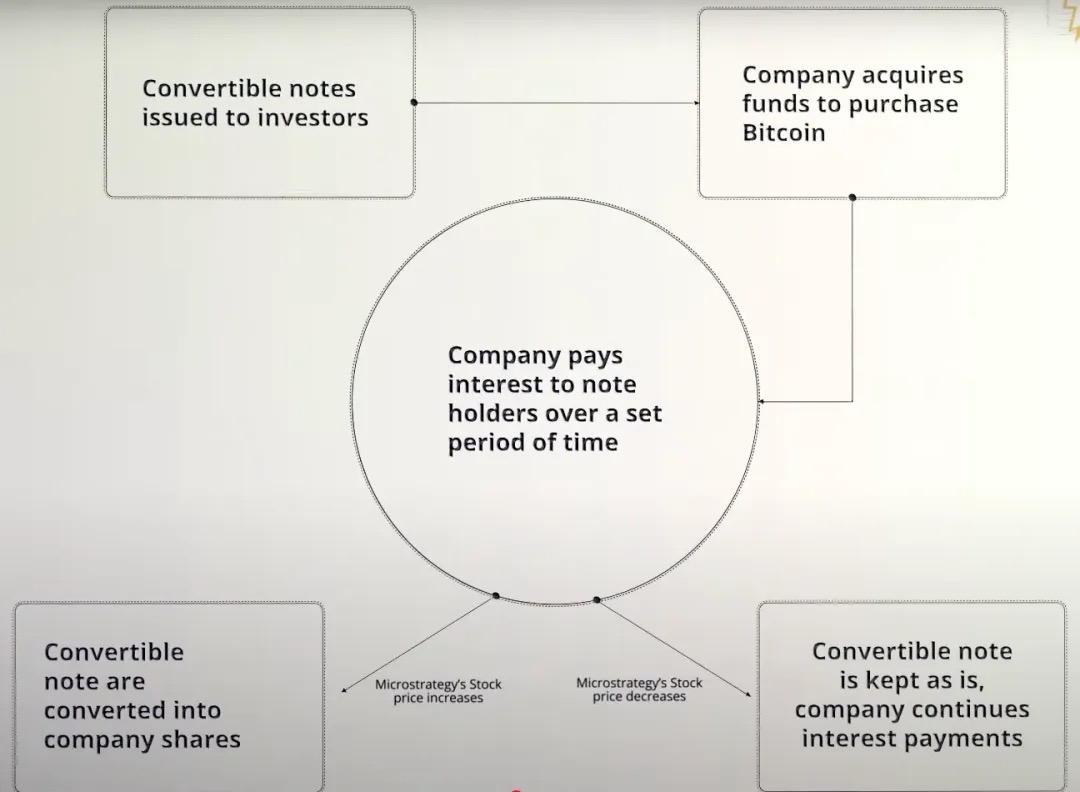
It is particularly important to emphasize that convertible bonds are essentially a combination of "regular bonds + call options," especially in the case of MicroStrategy (MSTR). The company continues to issue 0% interest convertible bonds, which means that investors receive no interest income during the bond's term.
So why are savvy institutional investors willing to accept such a "low-yield" structure? The answer lies in the value of the embedded call option: this embedded call option is particularly valuable under expectations of high implied volatility (IV) for MSTR, as the greater the expected price fluctuations, the higher the value of the option to capture upside opportunities.
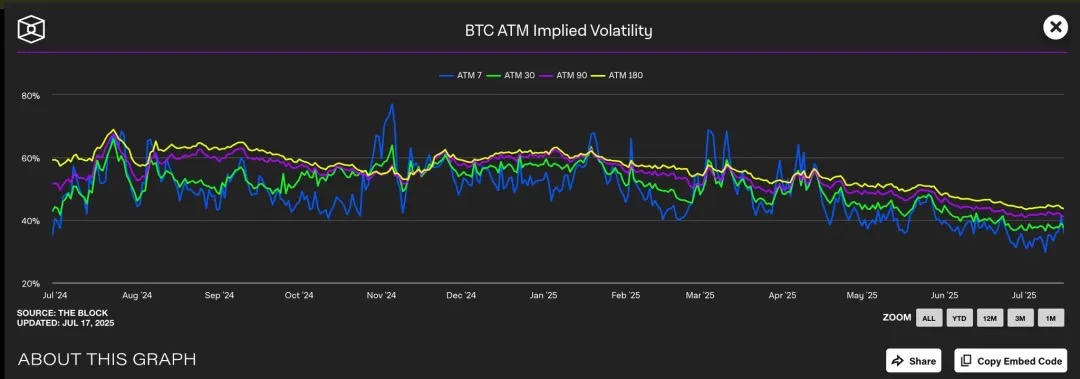
We observe that the implied volatility (IV) of Bitcoin typically ranges between 40% and 60% across different maturities. Since MicroStrategy's stock price is highly correlated with Bitcoin, this higher BTC IV indirectly raises the valuation of MSTR stock options.
Currently, at-the-money call options (with a strike price of about $455) are trading at an IV level of 45%, while the corresponding put options have even higher IV, indicating strong market expectations for future volatility. Such a high volatility environment significantly enhances the value of the embedded call options in MSTR's convertible bonds.
Essentially, MicroStrategy is effectively "selling" this call option to investors at a high premium. The greater the price fluctuations of the underlying asset, the higher the probability of being "in the money" at expiration, which makes call options more expensive during periods of high volatility.
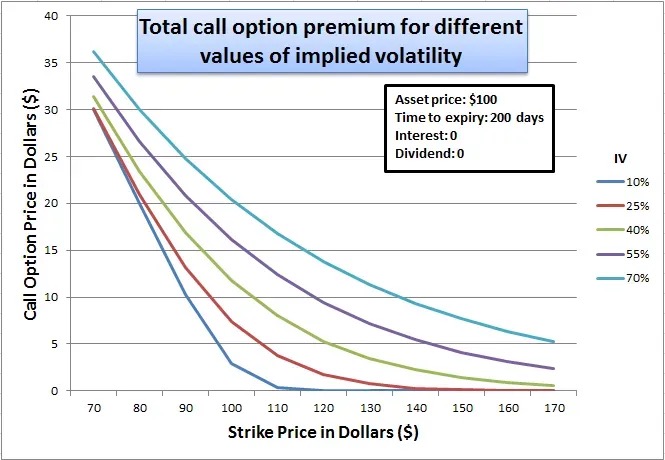
From the investor's perspective, this is acceptable because they are essentially purchasing a leveraged volatility bet: if MSTR's stock price surges, they can convert to stock and realize significant gains; if the stock price does not rise, bondholders can still recover their principal at maturity.
For MSTR, this is a win-win situation: on one hand, it can raise funds without paying interest and without immediately diluting equity; on the other hand, if the Bitcoin strategy is successful, it can service or refinance this debt solely through stock price appreciation. In this framework, MSTR is not just issuing bonds for financing but is "monetizing volatility," converting future appreciation expectations into cheap capital today.
Gamma Trading
Gamma Trading is a core mechanism for the sustainability of MicroStrategy's capital structure, especially in the context of its repeated issuance of convertible bonds. The company has issued billions of dollars in zero-coupon convertible bonds, and their main appeal lies not in traditional fixed income but in the value of the embedded call options within the bonds. In other words, investors are not concerned with the interest income from the bonds themselves but with the tradability and volatility arbitrage potential of the option component.
The buyers of these bonds are not traditional long-term creditors but hedge funds employing market-neutral strategies. These institutions widely engage in what is known as Gamma Trading, where the investment logic is not "buy and hold," but relies on continuous hedging adjustments to capture profits amid volatility.
The Gamma Trading mechanism in MSTR:
Basic Trading Structure:
Hedge funds buy MicroStrategy's convertible bonds (essentially bonds + call options);
Simultaneously, they short an equivalent amount of MSTR stock to maintain delta neutrality.
Why Establish This?
If MSTR's stock price rises, the call option in the bond appreciates faster than the losses from the short stock position;
If the stock price falls, the short position profits faster than the bond losses;
This symmetrical profit structure allows hedge funds to profit from volatility rather than directional changes.
Gamma and Rebalancing Mechanism:
As the stock price fluctuates, hedge funds must continuously adjust their short positions to maintain delta neutrality;
The initial hedge is set according to the bond's delta value; for example, if a convertible bond has a delta of 0.5, the fund will short $50 worth of MSTR stock to hedge a $100 bond;
However, as the stock price continues to fluctuate, the delta of the convertible bond itself will also change (reflecting gamma), requiring the fund to continuously rebalance:
If the stock price rises, delta increases (the bond behaves more like stock) → increase short position;
If the stock price falls, delta decreases (the bond behaves more like a bond) → cover short position;
This continuous "selling high, buying low" hedging trade is called Gamma Trading.
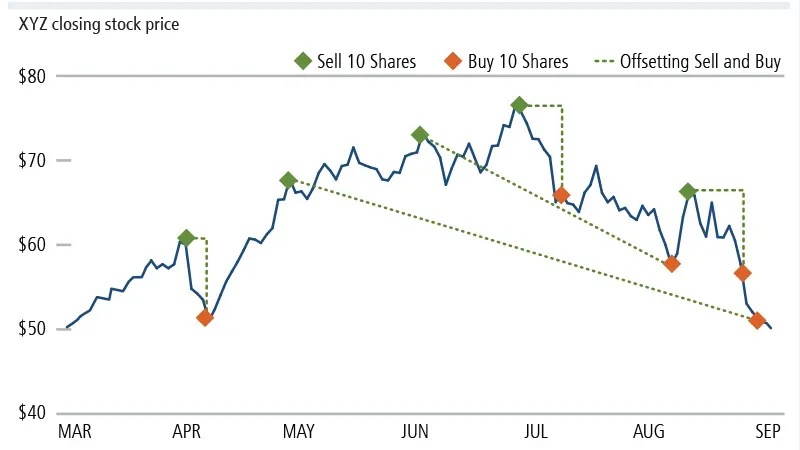
- In practice, the bond's delta changes non-linearly with the stock price, requiring constant adjustments to the short position to maintain neutrality.
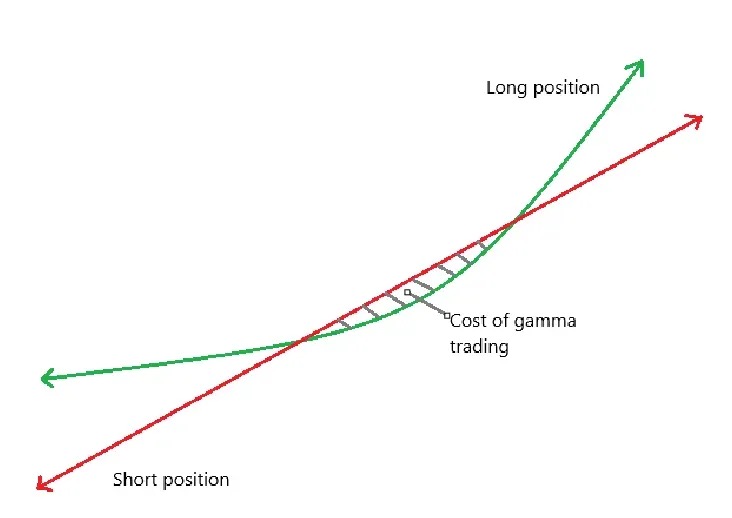
Green curve: returns from holding convertible bonds;
Red line: returns from shorting stock;
The difference between the two represents net profit and loss (P&L);
When the stock is flat and near the conversion range, frequent hedging operations may actually lead to losses, which is referred to as the "cost zone" of Gamma Trading (the shaded area in the figure).
Impact on MSTR Premium:
These gamma hedgers are not long-term holders;
When MSTR stock reaches the conversion price of the convertible bonds, delta → 1, gamma drops to very low levels;
If declining volatility or narrowing spreads lead to losses in gamma trading, these funds will exit the market, thereby weakening demand for convertible bonds.
Second-Order Effects:
MicroStrategy's convertible bonds are typically zero-coupon but have a long duration → low theta (time decay);
When volatility is too low, gamma trading becomes unprofitable, and gamma PnL ≪ theta decay (time decay);
Selling convertible bonds will become difficult, affecting their financing ability.
The comparison of short float illustrates the dominance of this strategy:
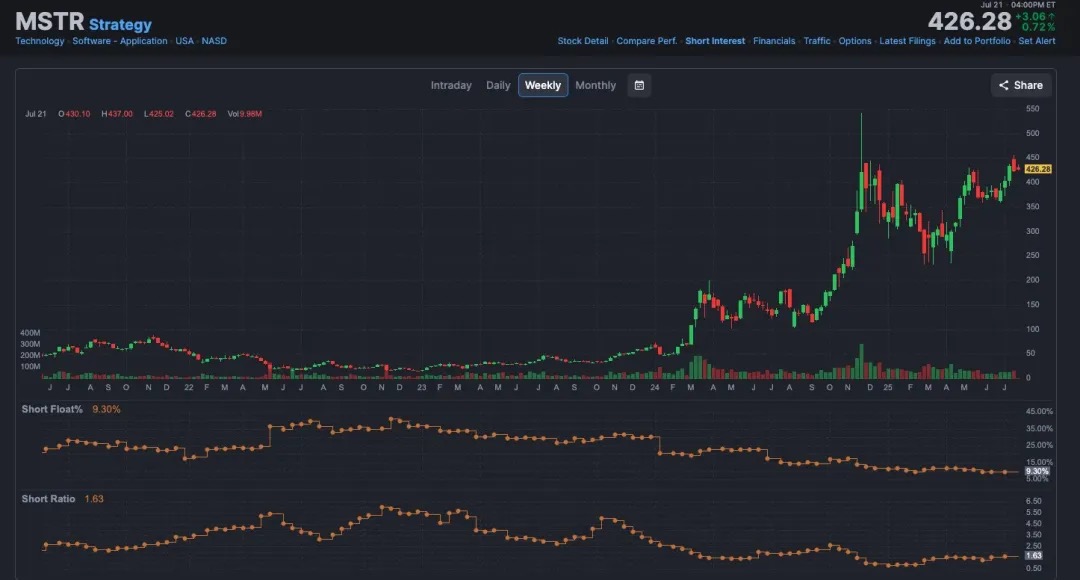
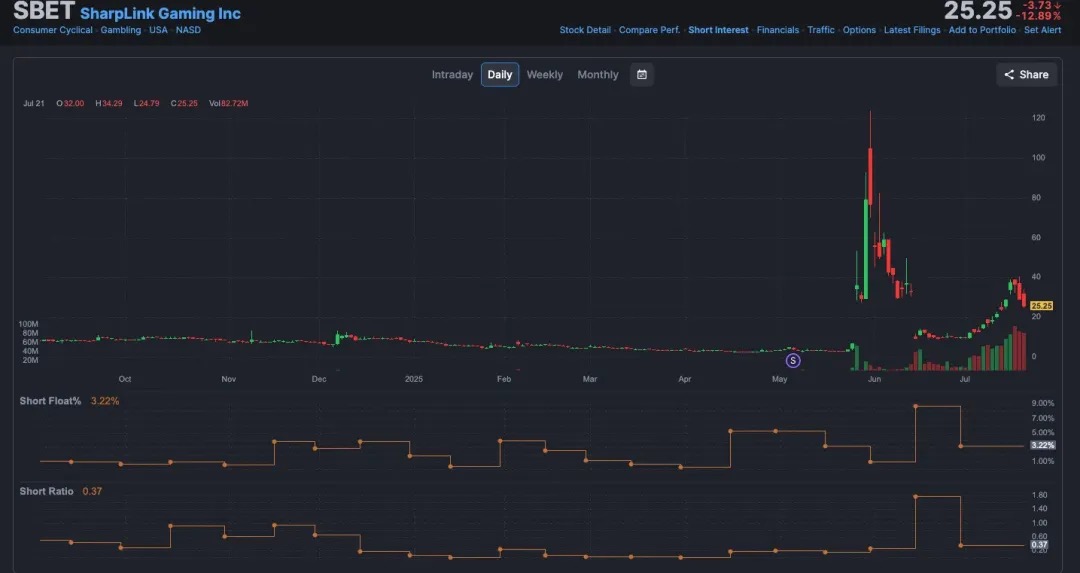
Short float refers to the proportion of a company's total outstanding shares that are shorted. We observe that MicroStrategy has a high short float due to its large issuance of convertible bonds, as funds engaging in gamma trading often need to short MSTR stock for delta-neutral hedging.
In contrast, SBET has not issued convertible bonds but relies on PIPE private placements and ATM at-the-market issuance mechanisms, lacking the structural arbitrage opportunities of convertible bonds + options, resulting in a significantly lower short float. SBET's financing structure is also closer to traditional financing, failing to attract large-scale arbitrage institutions to participate.
Performance
I tracked and analyzed the stock price reactions of 12 publicly listed companies after announcing cryptocurrency asset allocations in 2025. Our dataset includes stock price data before and after the announcement date, candlestick chart visualizations, and key performance indicators.
The average stock price reaction after the first cryptocurrency treasury announcement in 2025 was explosive, short-term, yet still resulted in positive cumulative returns.

Among the 12 publicly listed companies, the average 1-day return was +103.17%, indicating a strong immediate reaction from investors. The 5-day return further soared to +285.92%, with a pullback occurring on the 10th day, ultimately stabilizing at +102.03%. Although some companies performed flat or even negative, several experienced extreme stock price surges.
Example 1: BitMine Immersion Technologies Inc. (NYSE-American: BMNR)
This is a blockchain infrastructure company based in Las Vegas, operating industrial-scale Bitcoin mining facilities, selling immersion cooling hardware, and providing hosting services for third-party equipment in low electricity cost regions such as Texas and Trinidad. On June 30, 2025, the company raised approximately $250 million by issuing 55.6 million shares at a price of $4.5 per share through a private placement to expand its Ethereum treasury.
After the announcement, BMNR's stock price skyrocketed from $4.27 to a peak of $161, with a staggering increase of +3,674.9% within three days. This epic surge was likely driven by a thin float, high retail enthusiasm, and FOMO momentum. Despite a subsequent sharp correction, the cumulative increase over two weeks still reached +882.4%. This event highlights the market's positive feedback towards the "MicroStrategy-style" high-conviction cryptocurrency treasury strategy.
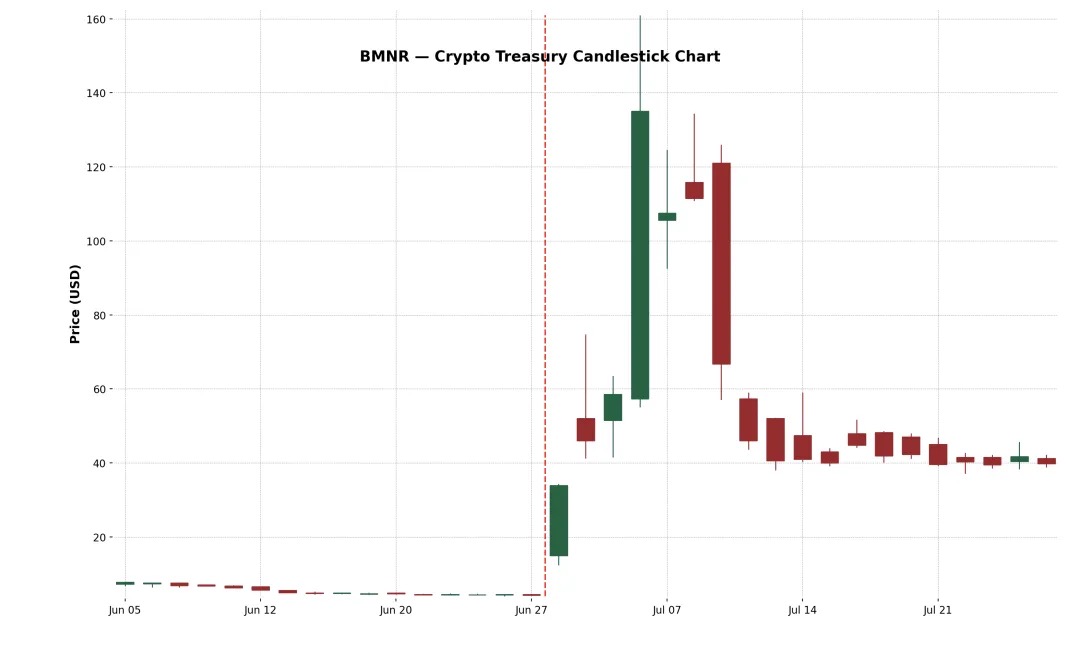
Example 2: SharkLink Gaming Ltd. (Nasdaq: SBET)
SharpLink, founded in 2019, is an online technology company focused on converting sports fans into bettors, with a platform that pushes sports betting and interactive gaming offers to users based on timeliness. The company began accumulating ETH on its balance sheet in 2025, financing through PIPE (private investment in public equity) and ATM (at-the-market issuance).
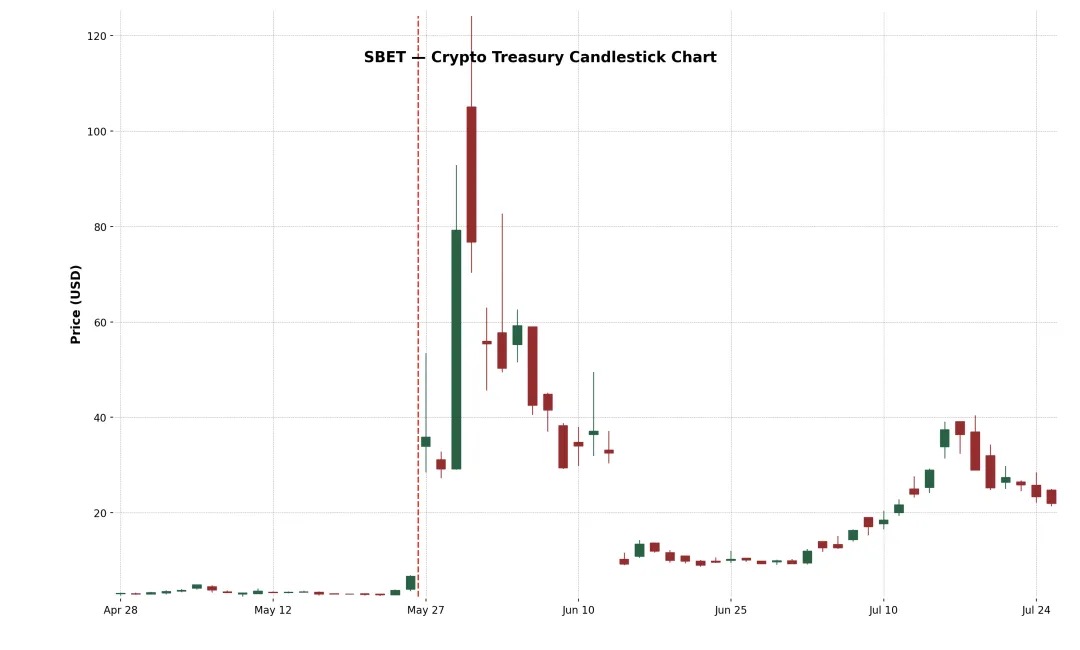
The initial stock reaction was extremely strong: SBET rose +433.2% on its first day, reaching a peak of +1,747% on the fourth trading day. This surge was driven by the scale of cryptocurrency asset allocation and the backing of prominent figures behind the trades. Retail investors, crypto funds, and speculative traders flocked in, pushing the stock price above $120.
However, the upward trend was short-lived. On June 17, SharpLink submitted an S-3 registration statement to the SEC, allowing PIPE investors to potentially resell their shares, causing widespread confusion. Many mistakenly believed that major shareholders were unloading their shares. Although Joseph Lubin, co-founder of Consensys and chairman of SBET, later clarified that "no shares have been sold yet," it was too late: SBET's stock price plummeted nearly 70%, erasing most of the gains made after the announcement.
Despite the sharp pullback, SBET's cumulative gain remained at +227.2%, indicating that the market still assigns significant long-term value to its ETH treasury strategy. Although it retreated from its peak, the stock began to regain funding support in the following weeks, suggesting that confidence in the "Ethereum as a reserve asset" model was recovering.
Example 3: Bit Digital Inc. (Nasdaq: BTBT)
BTBT is a digital asset platform based in New York, founded in 2015, initially operating Bitcoin mining facilities across the United States, Canada, and Iceland.
In June 2025, the company completed an underwritten offering, raising approximately $172 million, and reallocated capital to ETH by selling 280 BTC, purchasing about 100,603 ETH, officially completing its transition to an Ethereum staking and treasury model, with crypto veteran Sam Tabar as CEO.
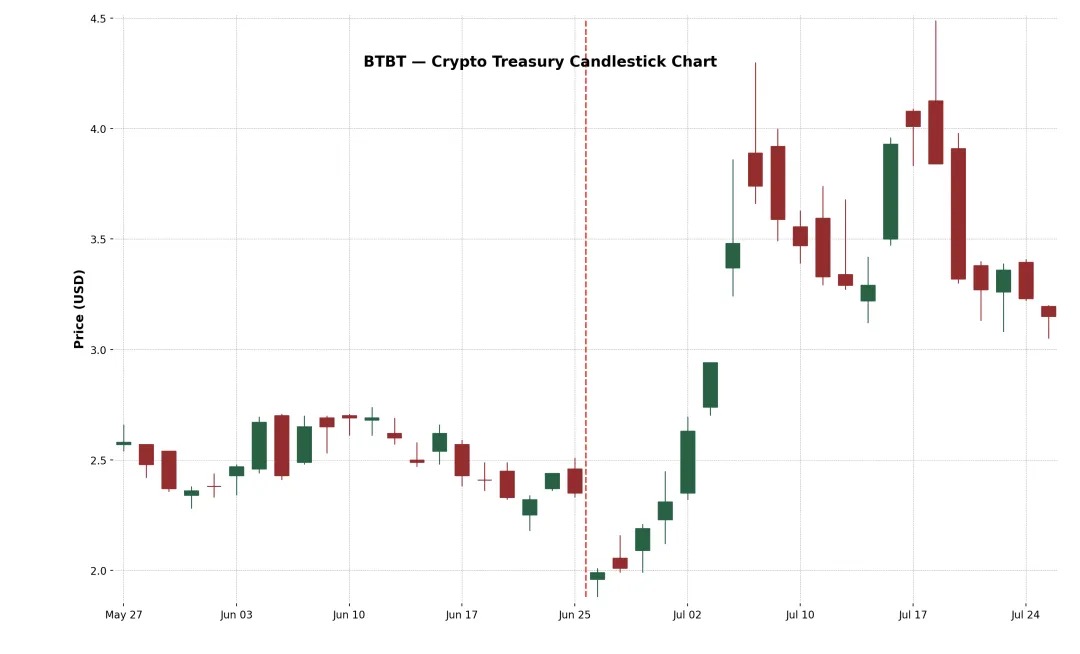
The initial market reaction was weak (down -15% on the first day), but the stock price gradually rose over the next two weeks, ultimately achieving a +91% increase. This moderate response may reflect the market's familiarity with BTBT's background in crypto mining. However, the +34% cumulative return still indicates that even established crypto companies can receive positive recognition from the market for further expanding their crypto asset allocations.
Example 4: GameStop Corp. (Nasdaq: GME)
However, GameStop (GME) announced its first Bitcoin purchase in May 2025 and plans to further transform into a consumer-grade gaming infrastructure company related to cryptocurrencies. Despite high retail investor interest and the significant symbolic meaning of this cultural meme stock entering the crypto asset space, GME's returns were negative on both the 5th and 10th days after the announcement. This performance disparity reveals a core insight: positive news about cryptocurrencies alone is not sufficient to sustain stock price increases.
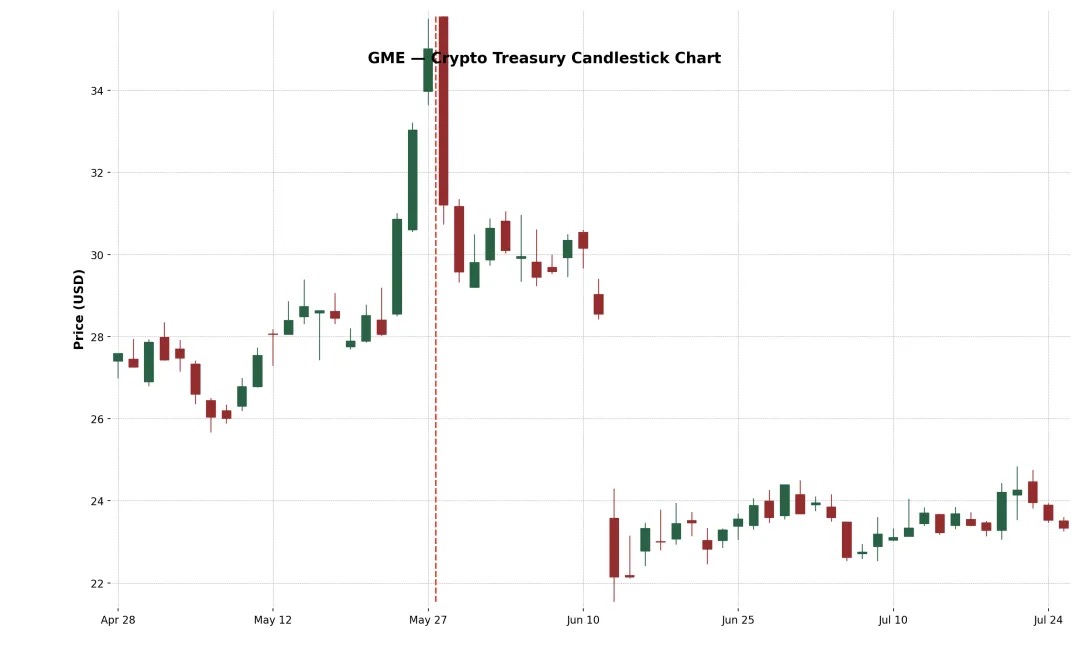
GameStop's Bitcoin strategy faced market skepticism due to its declining retail business, and this transformation came after multiple strategic shifts (such as stores, NFTs, metaverse, etc.).
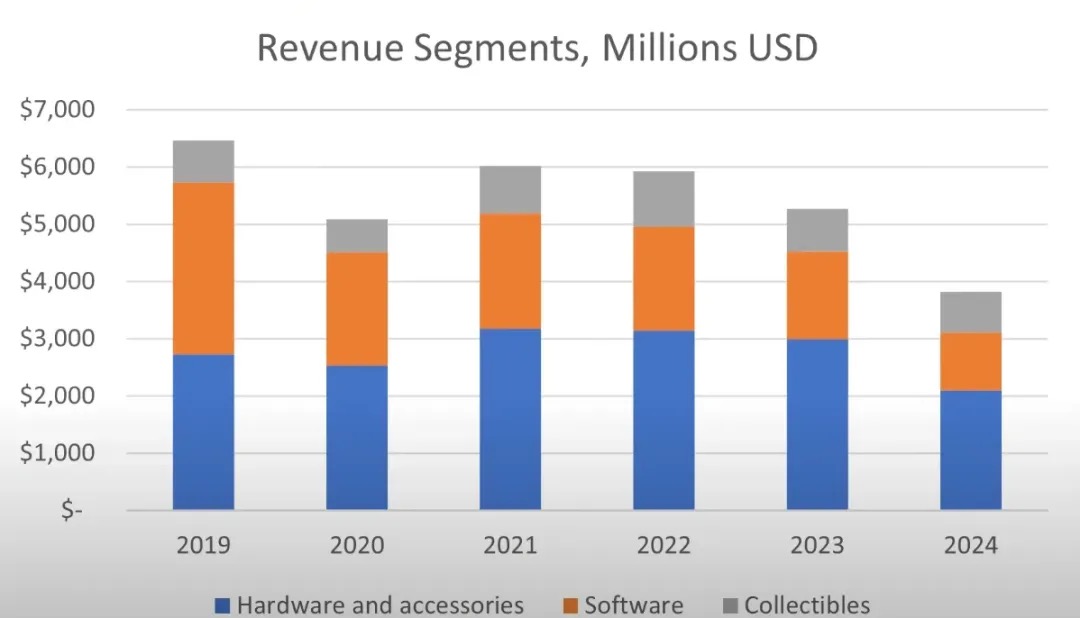
It failed to maintain an upward trend, reflecting market doubts about its fundamentals and strategic uncertainty. The company's core revenue continued to decline, and management had not proposed substantial reform plans beyond "buying Bitcoin." The conveyed message was also confusing, swinging from stores, NFTs, and the metaverse to now cryptocurrencies, severely undermining market confidence.

Cryptocurrency Asset Allocation Trends
In addition to Bitcoin, an increasing number of companies are beginning to use Ethereum (ETH) as their primary cryptocurrency reserve asset. The reasons are multifaceted. First, Ethereum is widely regarded as the underlying infrastructure for the tokenization of real-world assets (RWA), with protocols like Ondo, Backed Finance, and Centrifuge building institution-grade financial products on the Ethereum settlement layer. This positions ETH as a strategic reserve asset for companies betting on the trend of "traditional finance going on-chain."
Secondly, unlike Bitcoin, Ethereum is a stakeable and yield-generating asset, allowing holders to earn approximately 3-4% annualized returns by participating in network security. This gives ETH programmable and yield-bearing characteristics, making it highly attractive for CFOs seeking to optimize returns on idle cash.
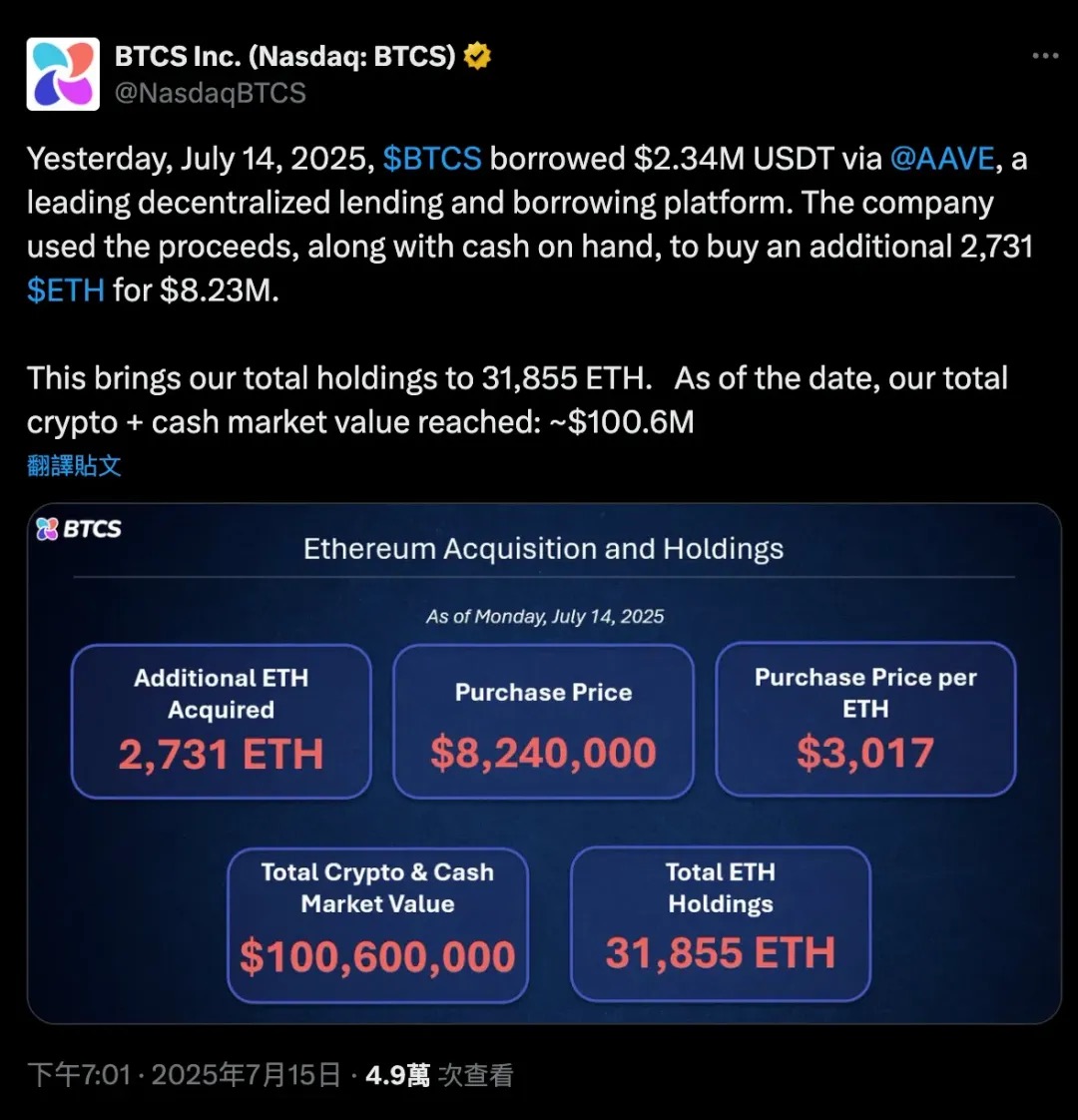
On July 14, 2025, BTCS borrowed 2.34 million USDT through Aave (a decentralized lending protocol) and, combined with some of its own cash, purchased 2,731 ETH, valued at approximately $8.24 million, further expanding its Ethereum holdings. This leveraged transaction brought BTCS's total ETH holdings to 31,855, increasing the company's overall crypto + cash market value to $100.6 million.
This case clearly demonstrates Ethereum's unique dual role in DeFi as both collateral and capital. Bitcoin is more of a "cold wallet" passive asset, often requiring wrapping to participate in DeFi; whereas ETH is a native composable asset that companies can use for lending, staking, or participating in yield protocols without selling the asset.
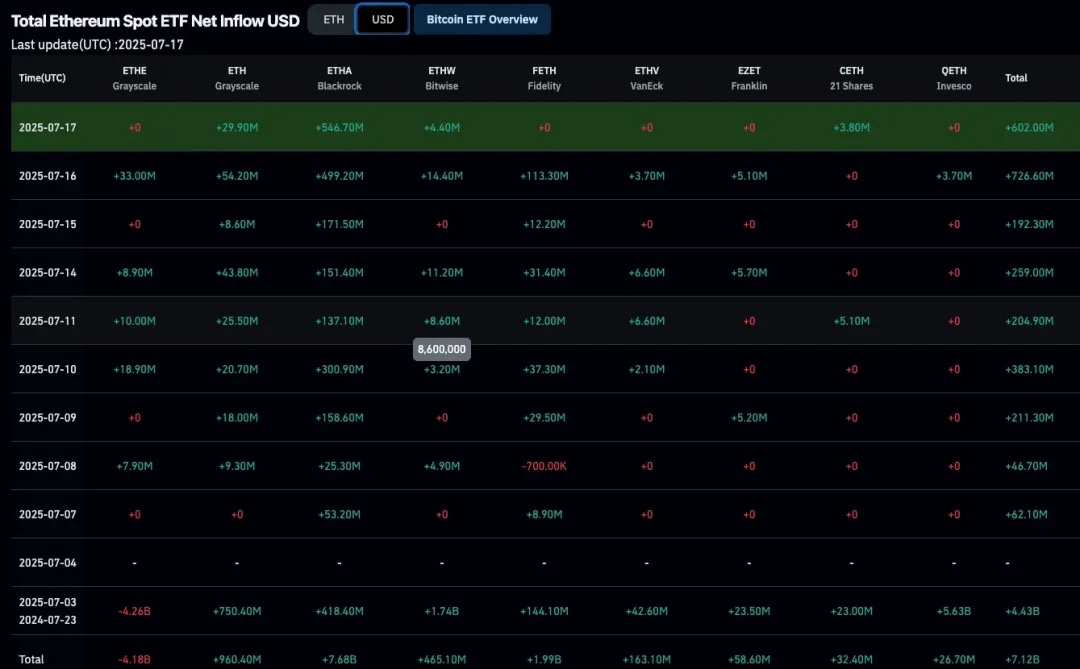
The launch of Ethereum spot ETFs further enhances institutional confidence and liquidity in ETH, with net inflows indicating that mainstream financial markets are gradually accepting ETH. Consequently, SharpLink (SBET), Bit Digital (BTBT), and even some private companies are adjusting their balance sheets to increase ETH holdings, which is not only a speculative bet but also expresses a long-term belief in "Ethereum as the underlying infrastructure of decentralized capital markets."
This trend marks a significant shift in the asset allocation strategies of crypto enterprises: from "Bitcoin = digital gold" to "Ethereum = digital financial infrastructure."
Here are several examples of this diversified allocation:
XRP as a reserve asset: VivoPower International (Nasdaq: VVPR) raised $121 million in May 2025, led by a Saudi prince, becoming the first publicly traded company to adopt an XRP reserve strategy. Shortly after, Singapore's Trident Digital Holdings (TDTH) announced plans to issue up to $500 million in stock to establish an XRP reserve; China's Webus International (WETO) also submitted an application to invest $300 million in XRP holdings and plans to integrate Ripple's cross-border payment network into its business system. These moves were influenced by Ripple's legal compliance status in the U.S., with mixed market reactions; although XRP rose in mid-2025, related stocks performed variably, but these actions indicate that crypto asset allocation is transcending the traditional dual focus on BTC and ETH.
Litecoin (LTC) reserve: MEI Pharma (MEIP), a small biotech company, unexpectedly announced a transformation in July 2025, raising $100 million through investments from Litecoin founder Charlie Lee and the Litecoin Foundation to create the first institution-grade LTC reserve plan. This plan was accompanied by a management change (Lee joining the board), and the market viewed it as an attempt to inject new momentum into the struggling biotech industry with crypto capital. The stock surged after the "biotech + Litecoin" news was released, but due to investor doubts about its ultimate business model, the stock price experienced significant volatility.
HYPE Token reserve: An even more "exotic" case comes from Sonnet BioTherapeutics (SONN), which announced a reverse merger worth $888 million in July 2025, establishing Hyperliquid Strategies Inc. and planning to incorporate $583 million in HYPE tokens into its balance sheet. This transaction was supported by mainstream crypto venture capital firms like Paradigm and Pantera, aiming to create the largest publicly traded entity holding HYPE tokens. SONN's stock price surged after the announcement (due to HYPE being a popular token), but analysts pointed out that its structure is complex and the token itself is still in its early stages. Similarly, Lion Group (LGHL) also secured a $600 million credit line to reserve tokens like HYPE, Solana, and Sui, creating a multi-asset crypto treasury.
When Will Saylor Sell Coins?
Michael Saylor has publicly stated that MicroStrategy will "HODL" its Bitcoin assets forever, meaning the company has no intention of selling its BTC reserves. In fact, MicroStrategy has even modified its corporate policy to formally establish Bitcoin as its primary treasury reserve asset, indicating a long-term holding plan. However, in the real world of corporate finance, "never selling" is not absolute. In certain scenarios, MicroStrategy may be forced to sell some Bitcoin. Understanding these potential scenarios is crucial, as they constitute the risk factors in the entire investment logic of "MicroStrategy as a Bitcoin proxy asset."
Here are some scenarios that could challenge MicroStrategy's resolve and "force" it to sell BTC:
Significant debt maturities in a tightening credit market: MicroStrategy currently has multiple outstanding debts, including convertible bonds maturing in 2028 and 2030 (having previously redeemed bonds maturing in 2025 and 2027 through stock issuance), and possibly other loans. Typically, companies refinance to repay old debts—issuing new bonds or new shares. In early 2025, MicroStrategy successfully redeemed its 2027 convertible bonds with stock, avoiding cash expenditures. But imagine a scenario: in 2028, Bitcoin is deep in a bear market, MicroStrategy's stock price plummets, and interest rates are high (new financing costs are too expensive). If $500 million to $1 billion in debt is due, the company may face a cash flow crisis.
In such a case, traditional capital markets may "close" their doors, especially when implied volatility (IV) is too low, leading to no investors willing to buy convertible bonds with embedded option value, which is MicroStrategy's most adept financing tool.
Faced with such credit tightening, the company may likely have to sell some BTC to repay debts, akin to being "forced to liquidate." Although MicroStrategy holds a massive amount of BTC (valued over $70 billion as of 2025), once utilized, market confidence is bound to waver. Such a sale would likely be a last resort, only undertaken when all other financing avenues have failed.
High interest burdens or preferred stock dividend pressures: While MicroStrategy's financing structure is flexible, it is not without cost. In 2025, the company's fixed expenditures include:
STRK annual interest rate of 8% (can be paid in cash or stock)
STRF annual interest rate of 10% (must be paid in cash, with penalties for default)
STRC monthly interest rate of 9-10% (cash payment, adjustable by the board)
Convertible bond interest (e.g., 0.625% coupon for 2030)
Total fixed liabilities exceed $180 million annually and may continue to rise with subsequent financing.
If MSTR's stock price is sluggish, direct equity financing will cause severe dilution.
If a crypto winter sets in, MicroStrategy may continue to burn cash to maintain cash dividends for STRF and STRC. If BTC remains low for an extended period, the company's leverage structure becomes dangerous. The board may decide to sell a portion of Bitcoin to "buy time," providing cash flow for interest or dividends in the next one to two years. While this contradicts the original intention, it is better than defaulting or triggering the cumulative default mechanism for STRF.
What if interest rates continue to rise? Then all future financing will become more expensive:
New preferred stock issuances must offer higher yields (e.g., >10%) to attract investors;
Convertible bonds must come with higher implied volatility to be accepted by the market (often difficult to achieve in a bear market);
If MSTR's stock price is sluggish, direct equity financing will cause severe dilution.
In other words, capital costs are rising, but revenues are not growing, and BTC is at a low point.
Summary: MicroStrategy is likely to sell coins only under extreme pressure or strategic shifts. These scenarios are often related to financial stress: difficulties in extending debt, excessively high capital costs, or market undervaluation of the company. Under normal circumstances, Saylor's strategy is to continue buying or holding, rather than selling. In fact, the company has already demonstrated this resolve: during the crypto market crash of 2022-2023, MicroStrategy did not sell BTC like Tesla did. Instead, it quietly repurchased some convertible bonds in the secondary market, achieving "discounted debt repayment," always prioritizing other means over selling Bitcoin, because once it sells coins, the entire "Bitcoin treasury" narrative would collapse, and market faith would waver.
Summary
MicroStrategy (MSTR) has pioneered a new corporate finance model, directly transforming a publicly traded operating company into a leveraged Bitcoin holding tool. By aggressively utilizing capital market tools, particularly zero-coupon convertible bonds, MSTR has managed to financialize its stock volatility, accumulating over 600,000 Bitcoins without relying on cash flow from its core business.
Its core mechanism is simple yet powerful: when the company's stock price trades at a premium relative to its BTC net asset value (mNAV) (i.e., mNAV > 1), it finances by issuing stock or convertible bonds (such as the "21/21" or "42/42" plans) and then converts all proceeds into BTC. Since MicroStrategy's stock price has long been above its BTC market value, this cyclical model has been sustained, allowing for simultaneous financing and increasing "Bitcoin per share."
At the center of this model, convertible bonds play a crucial role: they combine the downside protection of bonds (the bond floor) with the upside potential of stocks (embedded call options). In a high-volatility environment (like in 2025), investors are even willing to accept 0% interest simply because the option value is sufficiently high. Essentially, MSTR is not just issuing debt for financing; it is "selling volatility," and doing so at a premium. The market is willing to pay upfront for this future growth potential, enabling the company to continuously finance Bitcoin purchases without paying interest or immediately diluting shareholders.
However, this model also has limitations: once implied volatility contracts (whether due to market maturation or a lack of momentum in BTC), the value of embedded options will decline, significantly reducing the attractiveness of future convertible bond issuances. The company will have to rely on traditional financing methods or repay in cash when debts mature. Meanwhile, the "Gamma traders" and volatility arbitrageurs supporting MSTR's financing ecosystem are opportunists; once volatility decreases or market sentiment shifts, demand for their securities may quickly evaporate. This is not a "Delta risk" (everyone knows MSTR is a BTC proxy), but rather a "low Gamma risk," where small changes in expected volatility can lead to the entire financing mechanism failing.
Despite this, investing in MicroStrategy has become a new trend among institutional funds and retail investors, who view it as an alternative to trading Bitcoin. This speculative mindset is also reflected on-chain: users continuously purchase meme tokens related to "crypto treasury companies" or trade stocks like MSTR and SBET to bet on the narrative. Whether in traditional markets or DeFi, the underlying logic is consistent: crypto treasury companies represent a high-volatility, high-leverage alternative exposure to BTC, and if timed correctly, returns can even exceed those of the original asset itself.
In short, MicroStrategy has not only adopted Bitcoin as a reserve but has built an entirely new financial structure around it. It is the first successful "crypto treasury company" and may define a new paradigm for how future enterprises conduct treasury asset allocation, volatility monetization, and shareholder value creation, setting a benchmark in this Bitcoin-dominated financial world.
免责声明:本文章仅代表作者个人观点,不代表本平台的立场和观点。本文章仅供信息分享,不构成对任何人的任何投资建议。用户与作者之间的任何争议,与本平台无关。如网页中刊载的文章或图片涉及侵权,请提供相关的权利证明和身份证明发送邮件到support@aicoin.com,本平台相关工作人员将会进行核查。




